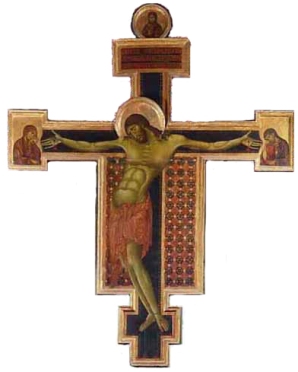|
|
Storia dell'arte - Story of Art
|
|
|
1300
By the end of Xlllth Century, the Painting became absolutely exclusive in Italy, thanks to some great artists like: Cimabue, Giotto and Ambrogio Lorenzetti. Cimabue expressed in his art a sort of relationship with the Neoellenistic art from Bisanzio, and also a relationship with the Romanic and Expressionst Art. Cimabue’s most famous work is “Il Crocifisso” in San Domenico di Arezzo, in which he perfectly expressed a Medieval Character with dramatic tones and static images. In 1288 Cimabue worked on the frescoes in the Chiesa Superiore di Assisi, that became his famous works. In those frescoes the artist showed a renovation and a new sense of monumentality. The Roman painter, Pietro Cavallini, got inspired by the Bizantine Culture and a little bit by the Paleochristian art. His masterpiece “Il Giudizio Universale” in Santa Cecilia in Rome has a great sense of humanity that makes the Bizantine style a little bit milder. The style of Cavallini was influenced from Giotto, especially regarding his works in Santa Maria d’ Aracoeli in Rome. Giotto represented, actually, the turning-point from the Bizantine from the Bizantine art to a new style. With Giotto the new fundamental artistic aspects were: a new sense of the space and depth. With a gradation of colors used by the painters the subject in the paintings is in evidence. Ambrogio Lorenzetti owned some similar aspects of Giotto’s style. In his work “l’Annunciazione” he used some fundamentals of perspective, that became very important in the art of XlV century. In Tuscany some aspects og Giotto’s style became very important , which have been often combined together with an international sense of gothic. The most important painters in Siena were: Simone Martini, Duccio di Boninsegna, Pietro and Ambrogio Lorenzetti.
|
|
|
